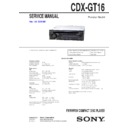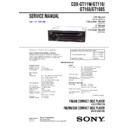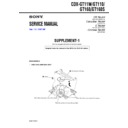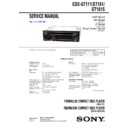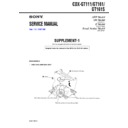Sony CDX-GT16 Service Manual ▷ View online
SERVICE MANUAL
Published by Sony Techno Create Corporation
Sony Corporation
Audio Business Group
SPECIFICATIONS
9-889-078-01
2008C04-1
©
2008.03
Russian Model
Ver. 1.0 2008.03
Model Name Using Similar Mechanism
CDX-GT220/GT227EE
CD Drive Mechanism Type
MG-101TC-188//Q
Optical Pick-up Name
DAX-25A
• The tuner and CD sections have no adjustments.
CD player section
Signal-to-noise ratio
Signal-to-noise ratio
95 dB
Frequency response
10 – 20,000 Hz
Wow and fl utter
Below measurable limit
Tuner section
FM
Tuning range
FM
Tuning range
87.5 – 108 MHz
Antenna terminal
External antenna connector
Intermediate frequency
10.7 MHz/450 kHz
Usable sensitivity
9 dBf
Selectivity
75 dB at 400 kHz
Signal-to-noise ratio
67 dB (stereo), 69 dB (mono)
Harmonic distortion at 1 kHz
0.5% (stereo), 0.3% (mono)
Separation
35 dB at 1 kHz
Frequency response
30 – 15,000 Hz
MW
Tuning range
Tuning range
531 – 1,602 kHz
Antenna terminal
External antenna connector
Intermediate frequency
10.7 MHz/450 kHz
Sensitivity 30
μV
SW
Tuning range
Tuning range
SW1: 2,940 – 7,735 kHz
SW2: 9,500 – 18,135 kHz
(except for 10,140 – 11,575 kHz)
Antenna (aerial) terminal External antenna (aerial) connector
Intermediate frequency
Intermediate frequency
10.7 MHz/450 kHz
Sensitivity 30
μV
Power amplifi er section
Outputs
Outputs
Speaker outputs (sure seal connectors)
Speaker impedance
4 – 8 ohms
Maximum power output 45 W
× 4 (at 4 ohms)
General
Output
Output
Power antenna relay control terminal
Inputs
Antenna input terminal
AUX input jack (stereo mini jack)
Tone controls
Low: ±10 dB at 100 Hz
High: ±10 dB at 10 kHz
Loudness
+9 dB at 100 Hz
+5 dB at 10 kHz
Power requirements
12 V DC car battery (negative ground)
Dimensions Approx.
178
× 50 × 179 mm
(7
1/8
× 2 × 7
1/8
in.) (w/h/d)
Mounting dimensions
Approx. 182
× 53 × 162 mm
(7
1/4
× 2
1/8
× 6
1/2
in.) (w/h/d)
Mass
Approx. 1.2 kg (2 lb. 11 oz.)
Supplied accessories
Parts for installation and connections (1 set)
Design and specifi cations are subject to change
without notice.
without notice.
CDX-GT16
FM/MW/SW COMPACT DISC PLAYER
CDX-GT16
2
UNLEADED SOLDER
Boards requiring use of unleaded solder are printed with the lead-
free mark (LF) indicating the solder contains no lead.
(Caution: Some printed circuit boards may not come printed with
Boards requiring use of unleaded solder are printed with the lead-
free mark (LF) indicating the solder contains no lead.
(Caution: Some printed circuit boards may not come printed with
the lead free mark due to their particular size)
: LEAD FREE MARK
Unleaded solder has the following characteristics.
• Unleaded solder melts at a temperature about 40 °C higher
• Unleaded solder melts at a temperature about 40 °C higher
than ordinary solder.
Ordinary soldering irons can be used but the iron tip has to be
applied to the solder joint for a slightly longer time.
applied to the solder joint for a slightly longer time.
Soldering irons using a temperature regulator should be set to
about 350 °C.
Caution: The printed pattern (copper foil) may peel away if the
about 350 °C.
Caution: The printed pattern (copper foil) may peel away if the
heated tip is applied for too long, so be careful!
• Strong
viscosity
Unleaded solder is more viscous (sticky, less prone to fl ow)
than ordinary solder so use caution not to let solder bridges
occur such as on IC pins, etc.
than ordinary solder so use caution not to let solder bridges
occur such as on IC pins, etc.
• Usable with ordinary solder
It is best to use only unleaded solder but unleaded solder may
also be added to ordinary solder.
also be added to ordinary solder.
Notes on chip component replacement
• Never reuse a disconnected chip component.
• Notice that the minus side of a tantalum capacitor may be dam-
• Never reuse a disconnected chip component.
• Notice that the minus side of a tantalum capacitor may be dam-
aged by heat.
NOTES ON HANDLING THE OPTICAL PICK-UP
BLOCK OR BASE UNIT
BLOCK OR BASE UNIT
The laser diode in the optical pick-up block may suffer electrostat-
ic break-down because of the potential difference generated by the
charged electrostatic load, etc. on clothing and the human body.
During repair, pay attention to electrostatic break-down and also
use the procedure in the printed matter which is included in the
repair parts.
The fl exible board is easily damaged and should be handled with
care.
ic break-down because of the potential difference generated by the
charged electrostatic load, etc. on clothing and the human body.
During repair, pay attention to electrostatic break-down and also
use the procedure in the printed matter which is included in the
repair parts.
The fl exible board is easily damaged and should be handled with
care.
NOTES ON LASER DIODE EMISSION CHECK
The laser beam on this model is concentrated so as to be focused
on the disc refl ective surface by the objective lens in the optical
pickup block. Therefore, when checking the laser diode emission,
observe from more than 30 cm away from the objective lens.
The laser beam on this model is concentrated so as to be focused
on the disc refl ective surface by the objective lens in the optical
pickup block. Therefore, when checking the laser diode emission,
observe from more than 30 cm away from the objective lens.
This compact disc player is classifi ed as a CLASS 1 LASER
product. The CLASS 1 LASER PRODUCT label is located on the
exterior.
product. The CLASS 1 LASER PRODUCT label is located on the
exterior.
This label is located on the bottom of the chassis.
• CD playback
You can play CD-DA (also containing CD TEXT), CD-R/CD-
RW (MP3/WMA fi les also containing Multi Session).
RW (MP3/WMA fi les also containing Multi Session).
Type of discs
Label on the disc
CD-DA
MP3
WMA
SERVICE NOTES
CAUTION
Use of controls or adjustments or performance of procedures other than
those specifi ed herein may result in hazardous radiation exposure.
Use of controls or adjustments or performance of procedures other than
those specifi ed herein may result in hazardous radiation exposure.
If the optical pick-up block is defective, please replace the whole
optical pick-up block.
Never turn the semi-fi xed resistor located at the side of optical
pick-up block.
optical pick-up block.
Never turn the semi-fi xed resistor located at the side of optical
pick-up block.
TEST DISCS
Please use the following test discs for the check on the CD section.
Please use the following test discs for the check on the CD section.
YDES-18 (Part No. 3-702-101-01)
PATD-012 (Part No. 4-225-203-01)
SAFETY-RELATED COMPONET WARNING!
COMPONENTS IDENTIFIED BY MARK 0 OR DOTTED LINE
WITH MARK 0 ON THE SCHEMATIC DIAGRAMS AND IN
THE PARTS LIST ARE CRITICAL TO SAFE OPERATION.
REPLACE THESE COMPONENTS WITH SONY PARTS
WITH MARK 0 ON THE SCHEMATIC DIAGRAMS AND IN
THE PARTS LIST ARE CRITICAL TO SAFE OPERATION.
REPLACE THESE COMPONENTS WITH SONY PARTS
WHOSE PART NUMBERS APPEAR AS SHOWN IN THIS
MANUAL OR IN SUPPLEMENTS PUBLISHED BY SONY.
MANUAL OR IN SUPPLEMENTS PUBLISHED BY SONY.
optical pick-up
semi-fixed resistor
CDX-GT16
3
1.
SERVICING NOTES
............................................. 4
2. GENERAL
Location of Controls ....................................................... 5
Connections
....................................................................
5
3. DISASSEMBLY
3-1. Sub Panel (LCD) Assy ................................................... 8
3-2. CD Mechanism Block ..................................................... 8
3-3. Main
3-2. CD Mechanism Block ..................................................... 8
3-3. Main
Board
..................................................................... 9
3-4. Servo
Board
.................................................................... 9
3-5. Chassis (T) Sub Assy ...................................................... 10
3-6. Roller Arm Assy .............................................................. 10
3-7. Chassis
3-6. Roller Arm Assy .............................................................. 10
3-7. Chassis
(OP)
Assy
........................................................... 11
3-8. Chucking
Arm
Sub
Assy
................................................. 11
3-9. Sled
Motor
Assy
.............................................................. 12
3-10. Optical Pick-up Section .................................................. 13
3-11. Optical Pick-up ............................................................... 13
3-11. Optical Pick-up ............................................................... 13
4.
DIAGNOSIS FUNCTION
..................................... 14
5. DIAGRAMS
5-1. Block Diagram –Main Section– ..................................... 17
5-2. Block Diagram –Display Section– ................................. 18
5-3. Printed Wiring Board –Main Section– ............................ 19
5-4. Schematic Diagram –Main Section (1/3)– ...................... 20
5-5. Schematic Diagram –Main Section (2/3)– ...................... 21
5-6. Schematic Diagram –Main Section (3/3)– ...................... 22
5-7. Printed Wiring Board –Key Section– ............................. 23
5-8. Schematic Diagram –Key Section– ................................ 24
5-2. Block Diagram –Display Section– ................................. 18
5-3. Printed Wiring Board –Main Section– ............................ 19
5-4. Schematic Diagram –Main Section (1/3)– ...................... 20
5-5. Schematic Diagram –Main Section (2/3)– ...................... 21
5-6. Schematic Diagram –Main Section (3/3)– ...................... 22
5-7. Printed Wiring Board –Key Section– ............................. 23
5-8. Schematic Diagram –Key Section– ................................ 24
6.
EXPLODED VIEWS
6-1. Main
Section
................................................................... 29
6-2. Front Panel Section ......................................................... 30
6-3. CD Mechanism Section .................................................. 31
6-3. CD Mechanism Section .................................................. 31
7.
ELECTRICAL PARTS LIST
.............................. 32
TABLE OF CONTENTS
CDX-GT16
4
SECTION 1
SERVICING NOTES
NOTE FOR REPLACEMENT OF THE AUX JACK (J901)
To replace the AUX jack requires alignment.
1. Insert the AUX jack into the KEY board.
2. Place the KEY board on the front panel.
3. Solder the three terminals of the jack.
To replace the AUX jack requires alignment.
1. Insert the AUX jack into the KEY board.
2. Place the KEY board on the front panel.
3. Solder the three terminals of the jack.
EXTENSION CABLE AND SERVICE POSITION
When repairing or servicing this set, connect the jig (extension
cable) as shown below.
When repairing or servicing this set, connect the jig (extension
cable) as shown below.
• Connect the MAIN board (CNP301) and the SERVO board
(CN2) with the extension cable (Part No. J-2502-076-1).
NOTE FOR REPLACEMENT OF THE SERVO BOARD
When repairing, the complete SERVO board (A-1201-631-A)
should be replaced since any parts in the SERVO board cannot be
repaired.
When repairing, the complete SERVO board (A-1201-631-A)
should be replaced since any parts in the SERVO board cannot be
repaired.
KEY board
front panel
AUX jack
SERVO BOARD
CN2
CN2
MAIN BOARD
CNP301
CNP301
J-2502-076-1

